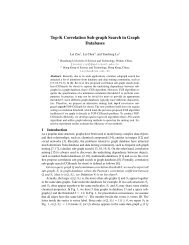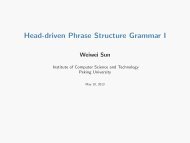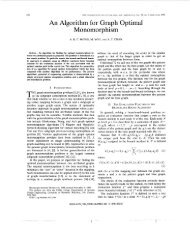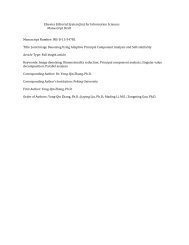PDF (1MB) - QUT ePrints
PDF (1MB) - QUT ePrints
PDF (1MB) - QUT ePrints
Create successful ePaper yourself
Turn your PDF publications into a flip-book with our unique Google optimized e-Paper software.
XML Data Clustering: An Overview · 33<br />
has exactly one or two children. The binary trees are then mapped to a numerical multidimensional<br />
vectors, called binary branch vectors, where the features of the vectors<br />
retain the structural information of the original trees. The binary branch vector can<br />
be extended to the characteristic vector, which includes all the elements in the q-level<br />
binary branch space.<br />
—Similarity Computation. Based on the vector representation, VectXClust defines a new<br />
distance, called the binary branch distance, of the tree structure as the L 1 distance between<br />
the vector images of two trees. The methodology is to embed the defined distance<br />
function, that is, the lower bound of the actual tree edit distance into a filter-and-refine<br />
framework. This allows filtering out very dissimilar documents and computing the tree<br />
edit distance only with a restricted number of documents<br />
—Clustering/Grouping. In fact, VectXClust does not conduct any clustering step. However,<br />
the measured distances between XML documents can be used later for any clustering<br />
process.<br />
6.1.9 DFTXClust. Clustering XML documents based on the time series representation<br />
for XML documents (DFTXClust) 9 [Flesca et al. 2005] proposes the linearization<br />
of the structure of each XML document, by representing it as a numerical sequence and,<br />
then, comparing such sequences through the analysis of their frequencies. The theory of<br />
Discrete Fourier Transform is exploited to compare the encoded documents in the domain<br />
of frequencies.<br />
—Data Representation. DFTXClust is only interested in the structure of XML documents,<br />
hence it limits the attention to start tags and end tags. Each tag instance is denoted<br />
by a pair composed by its unique identifier and its textual representation. Moreover,<br />
it is necessary to consider the order of appearance of tags within a document. To this<br />
end, given an XML document doc x , the authors define its skeleton as the sequence of<br />
all tag instances appearing with doc x . The system relies on the effective encoding of<br />
the skeleton of an XML document into a time series summarizing its features. To this<br />
purpose, the authors develop two encoding functions: A tag encoding function, which<br />
assigns a real value to each tag instances, and a document encoding function, which<br />
associates a sequence of reals with the skeleton of the document. In order to measure<br />
the impact of encoding functions in detecting dissimilarities among documents, several<br />
encoding schemes have been proposed.<br />
—Similarity Computation. Based on the pre-order visit of the XML document starting at<br />
initial time t 0 , the authors assume that each tag instance occurs after a fixed time interval<br />
△. The total time spent to visit the document is n△, where n is the size of tags(doc x ).<br />
During the visit, the system produces an impulse which depends on a particular encoding<br />
tag function and the document encoding function. Instead of using Time Warping<br />
to compare sequences, Discrete Fourier Transform (DFT) is used to transform document<br />
signals into vectors whose components correspond to frequencies in the interval<br />
[−0.5, 0.5]. Based on this representation, the authors define a metric distance called the<br />
Discrete Fourier Transform distance as the approximation of the difference of the magnitudes<br />
of the DFT of the two encoded documents. The result of this phase is a similarity<br />
matrix representing the degree of structural similarity for each pair of XML documents<br />
in the data set.<br />
9 We give the tool this name for easier reference<br />
ACM Computing Surveys, Vol. , No. , 2009.












